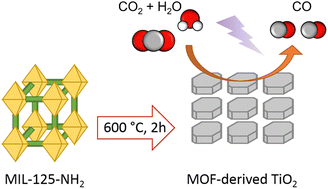M. Garvin, W. A. Thompson, J. Z. Y. Tan, S. Kampouri, C. P. Ireland, B. Smit, A. Brookfield, D. Collison, L. Negahdar, A. M. Beale, M. M. Maroto-Valer, R. D. McIntosh, and S. Garcia, Highly selective CO2 photoreduction to CO on MOF-derived TiO2 RSC Sustainability (2023) Doi: 10.1039/D2SU00082B

Abstract Metal–Organic Framework (MOF)-derived TiO2, synthesised through the calcination of MIL-125-NH2, is investigated for its potential as a CO2 photoreduction catalyst. The effect of the reaction parameters: irradiance, temperature and partial pressure of water was investigated. Using a two-level design of experiments, we were able to evaluate the influence of each parameter and their potential interactions on the reaction products, specifically the production of CO and CH4. It was found that, for the explored range, the only statistically significant parameter is temperature, with an increase in temperature being correlated to enhanced production of both CO and CH4. Over the range of experimental settings explored, the MOF-derived TiO2 displays high selectivity towards CO (98%), with only a small amount of CH4 (2%) being produced. This is notable when compared to other state-of-the-art TiO2 based CO2 photoreduction catalysts, which often showcase lower selectivity. The MOF-derived TiO2 was found to have a peak production rate of 8.9 × 10−4 μmol cm−2 h−1 (2.6 μmol g−1 h−1) and 2.6 × 10−5 μmol cm−2 h−1 (0.10 μmol g−1 h−1) for CO and CH4, respectively. A comparison is made to commercial TiO2, P25 (Degussa), which was shown to have a similar activity towards CO production, 3.4 × 10−3 μmol cm−2 h−1 (5.9 μmol g−1 h−1), but a lower selectivity preference for CO (3 : 1 CH4 : CO) than the MOF-derived TiO2 material developed here. This paper showcases the potential for MIL-125-NH2 derived TiO2 to be further developed as a highly selective CO2 photoreduction catalyst for CO production.